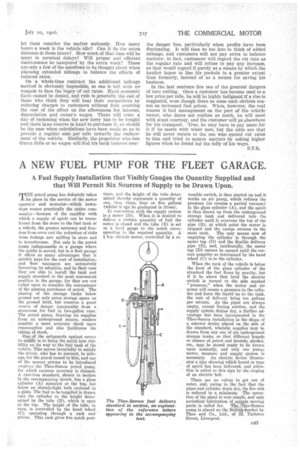A NEW FUEL PUMP FOR THE FLEET GARAGE.
Page 27

If you've noticed an error in this article please click here to report it so we can fix it.
A Fuel Supply Installation that Visibly Gauges the Quantity Supplied and that Will Permit Six Sources of Supply to be Drawn Upon.
THE petrol pump has definitely taken its place in the service of the motor operator and motorist—which nowadays means practically the entire community—because of the rapidity with which a supply of spirit can be transferred from the store to the fuel tank of a vehicle, the greater accuracy and freedom from error and the reduction of risks from leakage and spilling in store and in transference. Not only is the petrol pump indispensable in a garage where the public is served, but in a fleet garage it offers so many advantages that it quickly pays for the cost of installation, and fleet managers are extensively favouring its adoption, and in their case they are able to install the tank and supply standard in thd most convenient Position in the garage, for they are not called upon to consider the convenience of the passing purchaser of petrol. The placing of the storage tanks below ground not only saves storage space on the ground level, but removes a great source of danger inseparable from a storeroom for fuel in two-gallon cans. The petrol pump, drawing its supplies from an underground source, renders possible a more accurate check upon consumption and also facilitates the taking of stock.
One of the safeguards against errors In sufly is to bring the spirit into visibility on its way to the fuel tank of the vehicle. This serves invariably to satisfy the driver, who has to account, in mileage, for the petrol issued to hith, and one of the newest sytems to be introduced employs the Theo-Samoa petrol pump, for which extreme accuracy is claimed. A cast-iron standard, shown in section in the accompanying sketch, has a glass cylinder (A) mounted at the top, but below an electric-light bulb enclosed in a globe. The fuel to be uppliecl is drawn into the cylinder to the height determined by the tube (B), which is open at the top. The height of the tube, in turn, is controlled by the hand wheel (C) operating through a rack and pinion, This rack gives five notch posi
tions, and the height of the tube determined thereby represents a quantity of one, two, three, four or five gallons (whilst it can be graduated in litres).
In connection with the supply system is a meter (D). When it is desired to deliver a certain quantity of fuel the meter is closed and the tube (B) is set as a level gauge to the notch corresponding to the required quantity. A
h.p. electric motor, controlled by a re
versible switch, is then started up and it works an air pump, which reduces the pressure (or creates a partial vacuum) in the glass cylinder (A), and the spirit is then drawn up from the underground storage tank and delivered into the cylinder until it overruns the top of the pipe (B), at which point the motor is stopped and the excess returns to the store tank. The only means now of emptying the cylinder is through the meter tap (D) and the flexible delivery pipe (E), and, incidentally, the meter tap (D) cannot be opened until the correct quantity as determined by the hand wheel (C) is in the cylinder.
When the tank of the vehicle is below the level of the glass cylinder, of the standard the fuel flows by gravity, but if it be above that level the electric switch is turned to the side marked "pressure," when the motor and air pump will create a pressure in the cylinder, and force the liquid up to the tank, the rate of delivery being ten gallons per minute. As the pipes are always empty, except -during suction, and the supply system drains dry, a further advantage has been incorporated in the Theo-Samoa installation in the shape of a selector device placed on the side of the standard, whereby Supplies may be drawn from any one of six underground storage tanks, so that different brands or classes of petrol and benzoie, alcohol, etc., may be stored ready to , be drawn upon instantly, and only one pump, motor, measure and supply system is necessary. An electric device illuminateS a sign showingwhich brand or type of spirit has been delivered, and attention is called to this sign by the ringing of an electric There are no valves to get out of order, and, owing to the fact that the pipes and cylinder drain dry, the fire risk is reduced to a minimum. The operation of the plant is very simple, and only periodical lubrication of certain moving parts is called for. The,nco-Samoa pump is placed on the BritislOnarket by Theo and Co., Ltd., of 32, Tarletou Street, Liverpool.






























